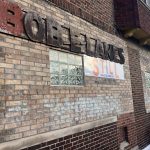A High Line for Philadelphia?
All the city news you can use.

Philadelphia. Photo by Dough4872, (CC BY-SA 4.0), via Wikimedia Commons
Every day at The Overhead Wire we sort through over 1,500 news items about cities and share the best ones with our email list. At the end of the week, we take some of the most popular stories and share them with Urban Milwaukee readers. They are national (or international) links, sometimes entertaining and sometimes absurd, but hopefully useful.
Philly’s potential future high line: Philadelphia has been trying to acquire the Reading Viaduct for two decades but the owner who purchased the asset from what remained of the Reading Railroad has been tough to work with or even contact. The city wants to create its own version of New York’s famous high line, but the former rail viaduct has just sat empty and unused. Now the city has given the green light to get the properties by any means necessary including condemnation. (Inga Saffron | Philadelphia Inquirer)
Auto truth in advertising needed: To own a car in Japan, a driver has to have proof of a place to park it and street parking has been illegal since 1957 due to limited space leading to more transit investment and safer streets. But in North America with what seemed like unlimited space, vehicles have grown over time in part due to advertising. By 2020, 79% of ads in periodicals in Canada featured an SUV or light truck. Étienne Tremblay suggests that perhaps it’s time to make car companies advertise what this really means for our health and safety. (Étienne Tremblay | Policy Options Politiques)
Why the Lahaina fire is so shocking: A wildfire that tore through Lahaina on the Hawiian island of Maui is shocking in that contrary to other recent devastating fires, the city doesn’t sit near a wildland urban interface and has been around for a long time. But the fire was aided by a few circumstances including drought dry invasive grasses that gave the fire more fuel and winds produced by a tropical cyclone. Some future solutions include more fire resistant buildings and subsidizing agricultural land to keep the grass out. (Henry Grabar | Slate)
Why people won’t stop moving to the sunbelt: Even as record breaking heat increases, the sun belt’s allure continues as people keep moving to its cities. The 50 counties with the highest heat risk grew 5% while those with the lowest lost population. A relatively inexpensive supply of housing, lots of jobs, and warm winters pulls people in even with higher risks in the summer. Some suggest that climate change will reverse that trend, but until there are more jobs and cheaper housing in those places, the trend will likely continue. (Olga Khazan | The Atlantic)
Quote of the Day
What often happens is that a [street] project gets to implementation, the NIMBYs jump up, and the bike aspect is the first thing to get cut. We want to make sure we’re shining the spotlight on these projects at those critical moments, so that they get across the finish line.
–Jenn Dice, CEO of People for Bikes in Streetsblog USA discussing a new advocacy portal for bike improvements.
This week on the podcast, we’re joined once more by Susan Crawford, author and Harvard Law Professor to talk about her new book, Charleston: Race, Water, and the Coming Storm. Susan chats with us about sea level rise, city solutions, and opportunities to rethink our responses.
Want more links to read? Visit The Overhead Wire and signup.
Urban Reads
-
Congestion Pricing Cuts Air Pollution in New York City
 Dec 14th, 2025 by Jeff Wood
Dec 14th, 2025 by Jeff Wood
-
We Think We Love to Drive. But Do We Really?
 Dec 7th, 2025 by Jeff Wood
Dec 7th, 2025 by Jeff Wood
-
Can Scott Wiener Tackle America’s Housing Crisis?
 Nov 23rd, 2025 by Jeff Wood
Nov 23rd, 2025 by Jeff Wood




















